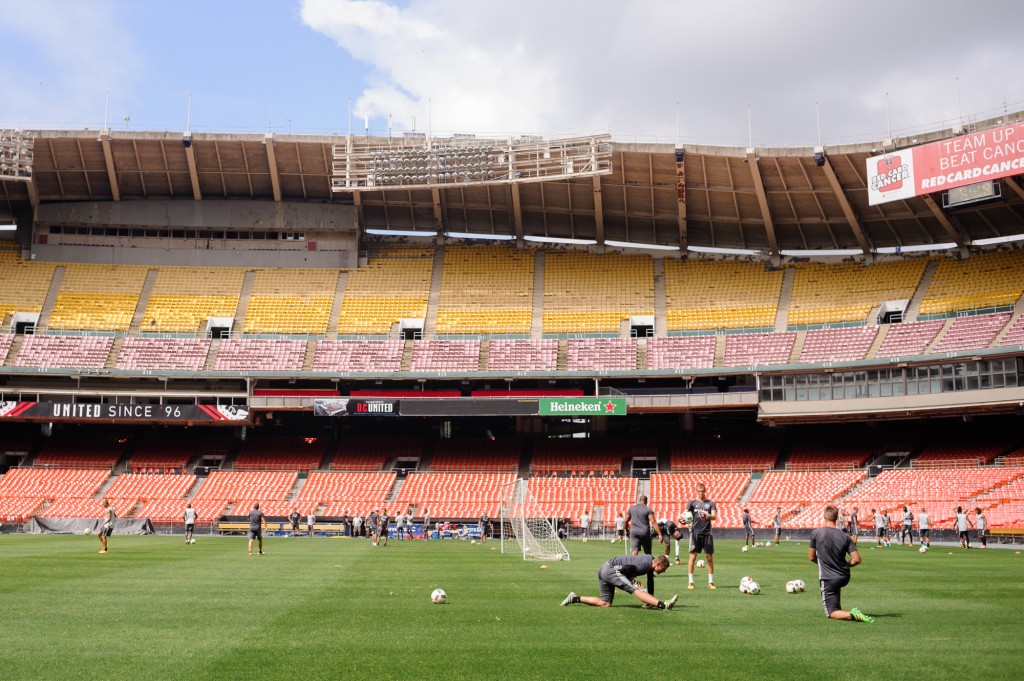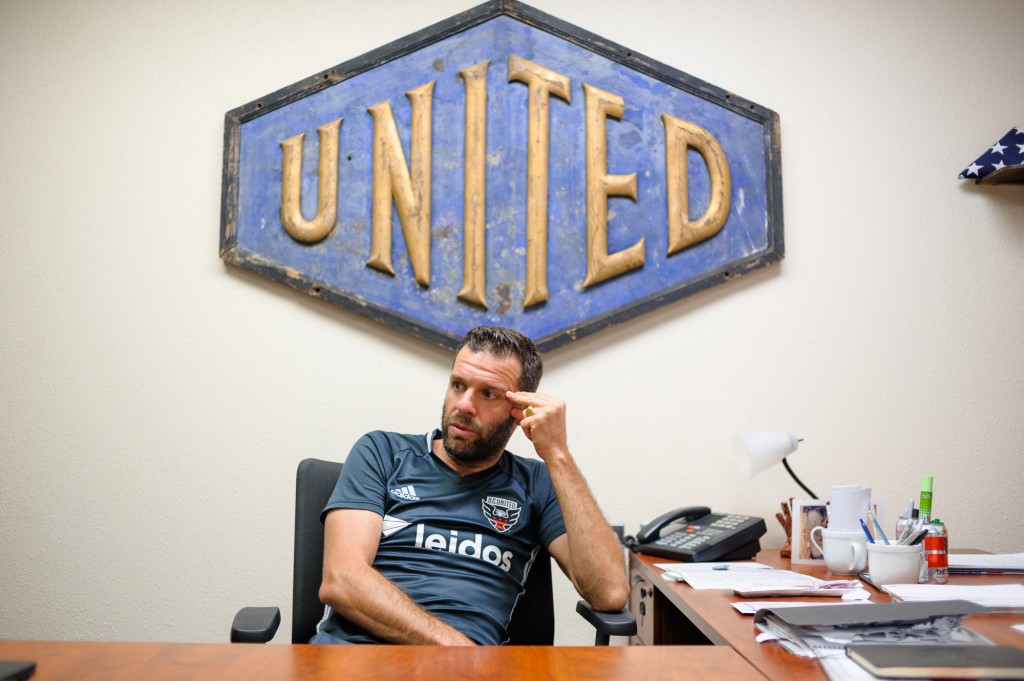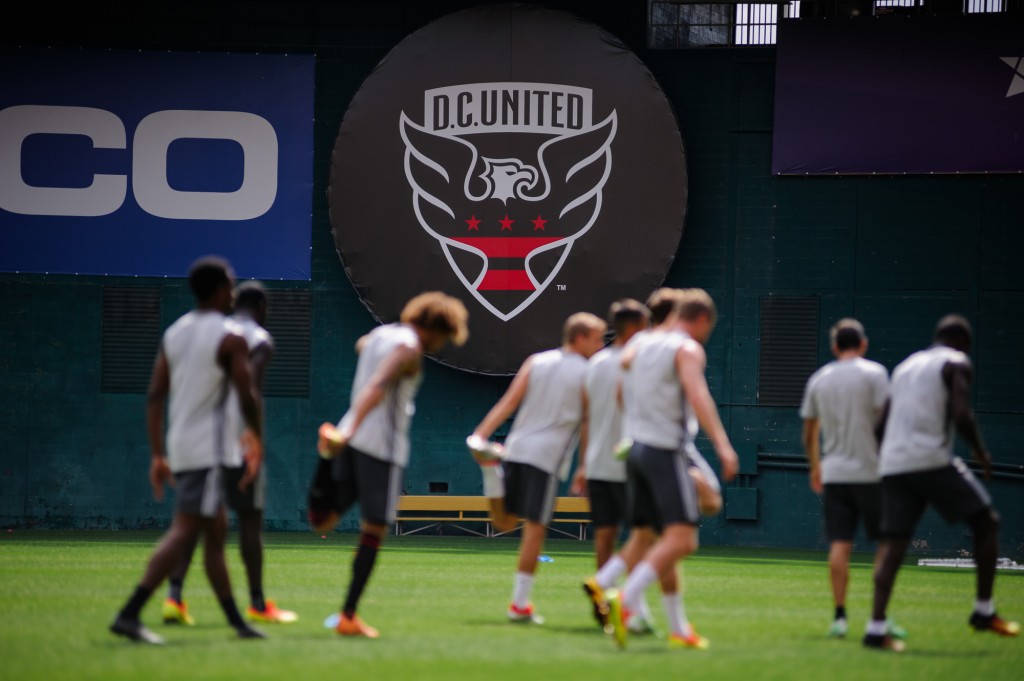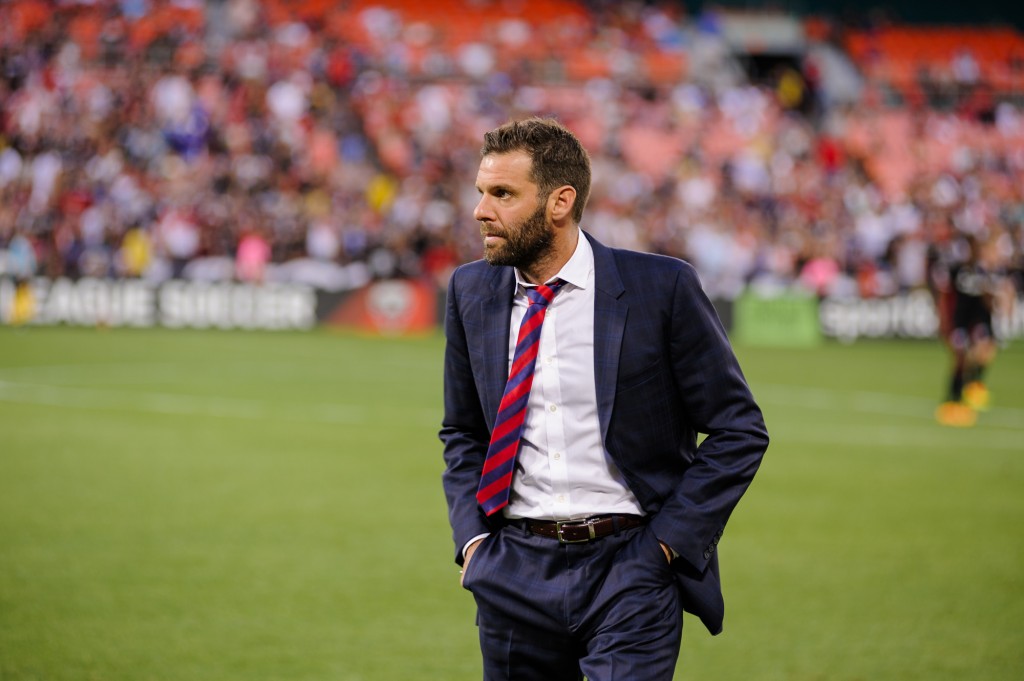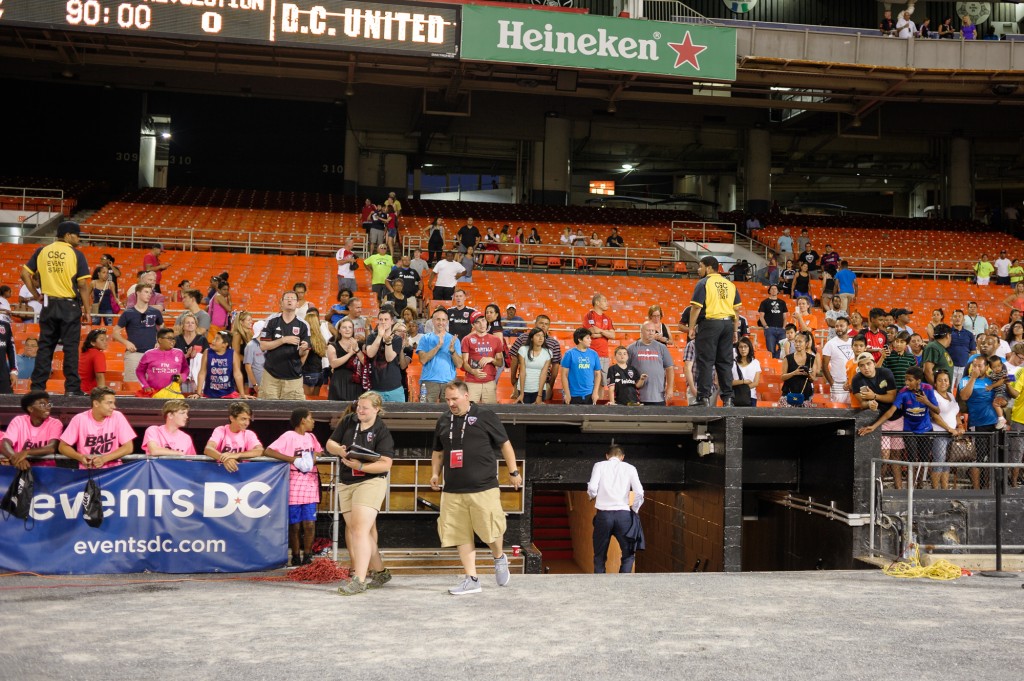
Ben Olsen’s RFK
By Jeffrey Anderson. Photographs by Andy DelGiudice
The players trickle out of the dugout at Robert F. Kennedy Memorial Stadium and onto a near-perfect pitch on a sunny Friday. Groundskeepers in gas-powered carts zip in and out of the main stadium tunnel and circle a dirt track that surrounds the field. United States and D.C. flags flap from the sloping roof that hovers over an empty stadium full of memories.
It’s the day before D.C. United hosts the New England Revolution, so today’s workout — open to the public for the first 15 minutes — will be light. Soccer balls roll seemingly out of nowhere in various directions as the players assemble into small groups to stretch, loosen up and deftly roll the leather between practice goalposts that shorten the pitch.
United Coach Ben Olsen eventually ambles out of the dugout in shorts, training shoes and a white cap. He sets a cup of coffee on a table full of water bottles, finds a ball and he too starts to limber up, though with a slight limp owing to a torn meniscus and recent surgery—one of many he’s endured in his 19-year career with the club, 12 as a player. Once loose, he playfully juggles a bouncing ball and, unnoticed by the team, deposits it into an empty net and raises his hands in mock glory.
“He’s been known to hop in and have a kick around,” communications specialist Sam Legg says of Olsen, who clearly still thinks with his feet: Earlier this year the veteran coach caught a one-game suspension and a fine when he cleared an errant second ball that had wandered onto the field.
After a shortened practice, Olsen meets with District Dig to reflect not so much on his United career, during which he ranked second in games played, minutes played and game-winning goals, but on the team’s 20-year residency at RFK. Standing 5-feet 8-inches, lean and muscular, the bearded Olsen has the no-nonsense urgency of a man with a thousand things on his mind. But talk of the old stadium that has been his place of business for most of his adult life seems to slow his pace a little. “I love this place,” he says. “I like everything about it. I like things that are old.”
Olsen’s family is “a bunch of junkers,” he explains, referring to relatives in the antique business, as he settles in behind his desk underneath a salvaged painted wood sign that reads “UNITED.” He is at home here, at the helm of a team with a legacy inseparable from the building where it resides. “It’s still a great place to watch soccer,” Olsen says of RFK on game days. “It’s a great venue. I mean, it’s old, there’s leaks, the temperature gauges are different everywhere you go. Some things we’ve all learned to live with and in some ways learned to appreciate.”
Newer stadiums around the league are designed specifically for soccer and are “lighter, less bulky, less cement-based,” says Olsen. “But if you can look past the bad paint job, from the outside the design of the building is cool. It was before it’s time.”
Washingtonians revere RFK for their memories of the Redskins, who played to one of the more crazed fanbases in the National Football League. Olsen is not exactly sure if United’s fans put a similar voodoo on opponents, but still, there is a certain aura. “I will say that as cavernous as the building is, for what we put in here numbers wise, it still holds sound,” he says. “Say 20,000 are here, it can seem like 35,000 in another building. That’s a credit to our fans and the atmosphere they [create].”
Major League Soccer boasts premier venues around the country — stadiums built explicitly for soccer, as is planned for United’s future home near Buzzard Point. “I’ve gone around the country being part of these [other buildings] and seen them erected in city after city,” he says, noting the energy of venues in Portland, Seattle and Kansas City, to name a few. “It’s been exciting to see how [soccer] has grown. In some ways I think maybe it’s good that we’re last [in getting a new stadium] and we can make it one of the best venues in the country.”
United and its fans still have time to savor — or endure, depending on your viewpoint — RFK. Residing in a stadium with such a varied past has its trials, says Olsen. “We’re still tenants,” he says. “A big concert will take priority.” Still, Olsen hopes United’s history will have its place in the RFK canon. “The next year-and-a-half [the legacy] is gonna be a big story. It will be interesting to see how much of that is about us. We’re not gonna be on SportsCenter, but I hope we’ll be part of the discussion. I hope soccer will be a big part of it.”
Olsen’s sense of pride is hard-earned. He has played here through injuries, scored crucial goals in big situations, and earned a reputation for heart and toughness. Now, however, his perspective has expanded. Even as a coach, he still has occasion to watch games from the vantage point of a fan. “Most of my views off the field have been from being kicked out of games,” he says, barely cracking a smile. “But we’re all part-time scouts, and international games and big teams come through. It’s strange to watch as a fan and see a coach at that bench where I’ve been sitting for a number of years.”
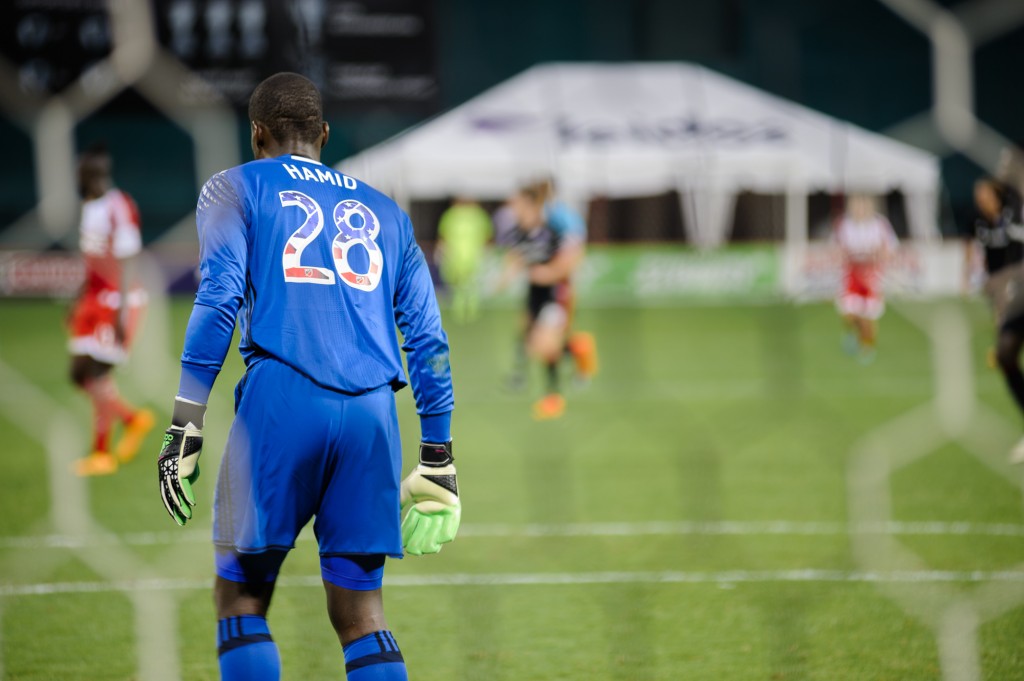 As a longtime D.C. resident, Olsen nurtures his affinity for RFK while trying to relate to young players from around the world. Do they appreciate that Pelé, Johan Cruyff, and Giorgio Chinaglia played here in the flagship North American Soccer League? “I think it depends how much time they spend with the club, or did [they] grow up around here,” Olsen says. “Those are factors that will decide whether, ok, this is my club, it’s where I show up to go to work, punch in and do my job. But I’m a competitive guy, and I’ve been able to stay with one team. If you stick around like Bobby Boswell, or Bill Hamid, who grew up [in Annandale], it’s near and dear to their heart, and maybe they’re a little more romantic about this club.”
As a longtime D.C. resident, Olsen nurtures his affinity for RFK while trying to relate to young players from around the world. Do they appreciate that Pelé, Johan Cruyff, and Giorgio Chinaglia played here in the flagship North American Soccer League? “I think it depends how much time they spend with the club, or did [they] grow up around here,” Olsen says. “Those are factors that will decide whether, ok, this is my club, it’s where I show up to go to work, punch in and do my job. But I’m a competitive guy, and I’ve been able to stay with one team. If you stick around like Bobby Boswell, or Bill Hamid, who grew up [in Annandale], it’s near and dear to their heart, and maybe they’re a little more romantic about this club.”
Then there’s the quirks of place and community. The stadium offers culinary pleasures foreign to most mainstream sports venues, such as pupusas and Pollo a la Brasa. “It’s the best food they offer!” Olsen says. “My wife walks right past the chicken fingers for the pupusas.”
Ethnic twists on stadium grub are mere signs of a deeper experience at RFK for Olsen. “Growing up in a small town in Pennsylvania I wasn’t exposed to this many cultures,” he says. “I feel lucky to cross paths with so many walks of life. It’s a part of this job. Understanding [international players] and where they come from, psychologically, is very important. Someone from Scandinavia is gonna be different than someone from Bolivia — their belief system, how they play — and you try and blend that into something that is in the American spirit, with these kids who are from around here. It’s exhausting and fun at the same time.”
RFK affords a family atmosphere, Olsen says. Players bring their children to the field from time to time. A player’s shelf life is limited, he says, so why not? “My son is into it. He loves the guys, knows the players names, knows the songs [that supporters chant throughout the game.] It’s occurring to my kids that I’m the coach of D.C. United, and it’s pretty neat to them.” At the same time, kids these days have so many opportunities in this country, Olsen continues. “They have 50 different things to pursue,” he says. “In some countries soccer is big chunk of the opportunity, but you can turn pro in anything in this country. You can turn pro in robot making. There’s so many things. I tell my kids, ‘You like this? You can do this, there’s a path.’ That’s unique and cool in this country.”
Olsen’s path led him to D.C. United, and RFK, and he has never looked back: “Nobody will ever doubt my love for this club and what it means to me,” he says.
A brutal sun has dipped below RFK’s potato chip-shaped roof on a Saturday night in June, and United supporters within the Barra Brava, Screaming Eagles and District Ultras are pounding drums, chanting, and waving red and black flags. They are enjoying a two-goal lead but the coach is anything but relaxed, pacing the sideline in a suit and a loosened tie. It’s a distinguished yet somehow workmanlike look that contrasts with the overly casual, sweatsuit-or-khaki set typically found on the sidelines of American football games.
This is Olsen’s house, as evidenced by a poster below the supporters’ section with his profile silhouetted over the D.C. flag with the word “LEADER” in bold letters. His team badly needs a victory to keep its playoff hopes alive, and he cannot sit still. He parks it on the bench top with his elbows on his knees, then jumps off; he holds his head in his hands in exasperation, then rests his hands on his hips; he yells and gestures to his players, then stuffs his hands into his pants pockets. As the game wears on, he uses allotted substitutions and greets players coming off the field with some dap, or a pat on the back.
[metaslider id=”1503″]Supporters remain on their feet and cause the lower sections of the stadium to bounce up and down in rhythm, as United claims its victory. At the final whistle, players drop to their knees or on their backs in exhaustion, but only for a moment before they wander over to the stands to shake hands, exchange hugs or sign autographs. Olsen moves around the field, congratulates his players and acknowledges their opponents. Eventually he approaches United supporters on the far side of the field and claps and waves his hands in appreciation of their loyalty and generosity of spirit.
As the crowd thins out and players leave the field, he turns back toward the bench and stops to do an on-field TV interview, then sheds his suit jacket and looks for a path to the locker room. In the middle of it all, his reserve players line up and take wind-sprints. He marches past them and stragglers on the field — including The Dig — and into the dugout. Through a tunnel, and various temperature changes, he heads toward his inner sanctum, where he can savor another night, another win, in a hallowed building whose days are numbered.


